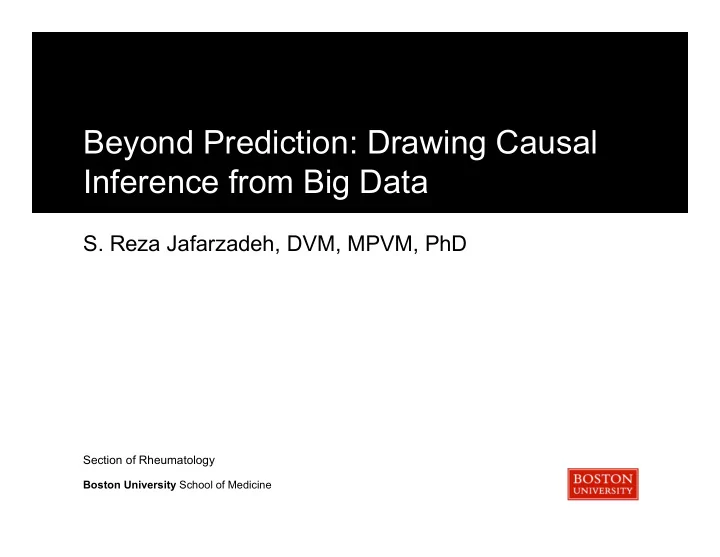

Beyond Prediction: Drawing Causal Inference from Big Data S. Reza Jafarzadeh, DVM, MPVM, PhD Section of Rheumatology Boston University School of Medicine
2 Disclosure Boston University Slideshow Title Goes Here Funding NIH R03, R21 Rheumatology Research Foundation Innovative Research Award Pfizer Global Awards for Advancing Chronic Pain Research Boston University School of Medicine
3 Beyond Prediction Boston University Slideshow Title Goes Here To identify a disease (an outcome/exposure) in a big data Machine learning ICD-10 codes Questionnaire “Have you ever been told by a doctor or other health professional that you have some form of arthritis, rheumatoid arthritis, gout, lupus, or fibromyalgia?” Boston University School of Medicine
4 Prediction; Problem Boston University Slideshow Title Goes Here Uncertainty Sensitivity: Pr(T+|D+) Specificity: Pr(T-|D-) Probability Laws 0 Pr 1 Pr(A or B) = Pr(A) + Pr(B) If A and B are independent Boston University School of Medicine
5 Prediction with Uncertainty Boston University Slideshow Title Goes Here We want perfect prediction (i.e., T+ = D+) Our prediction could be True or False Pr(True or False) = Pr(True) + Pr(False) Pr(True Positive) = Prevalence * Se Pr(False Positive) = (1 – Prevalence)*(1 – Sp) Pr(T+) = Prevalence * Se + (1 – Prevalence)*(1 – Sp) Quantitative bias analysis Incorporate uncertainty Boston University School of Medicine
6 Inference with Uncertainty Boston University Slideshow Title Goes Here “Have you ever been told by a doctor or other health professional that you have some form of arthritis, rheumatoid arthritis, gout, lupus, or fibromyalgia?” 54.4 million adults (22.7% of US population) reported by CDC* 91.2 million adults ( 36.8% of US population) * Barbour et al 2017 Boston University School of Medicine
7 Causal Inference; Big Data Boston University Slideshow Title Goes Here Data is random Get a distinct realization by repeating an experiment Data distribution can be learned By repeating an experiment Need to represent data-generating distribution That corresponds to observed data By a statistical model Boston University School of Medicine
8 Causal Inference; Target Boston University Slideshow Title Goes Here Define a target: What we wish to learn from data Average treatment effect (ATE) � Model coefficients � I want to exponentiate model coefficients to get odds ratios � Estimate target parameter Parametric modeling Machine learning Incorporate uncertainty in estimating target Use statistical theory Boston University School of Medicine
9 Randomized Longitudinal Study Boston University Slideshow Title Goes Here Causal treatment effect can be validly estimated Treatment assignment randomized at each visit A : treatment (or exposure) L : measured confounders U : unmeasured/unknown confounders Y : outcome Randomized treatment assignment depends only on Prior treatment history Boston University School of Medicine
10 Randomized Longitudinal Study Boston University Slideshow Title Goes Here Causal treatment effect can be validly estimated Treatment assignment randomized at each visit A : NSAID, physical activity L : age, sex, BMI, pain U : genetics, physically-demanding job Y : radiographically-measured joint space width Randomized treatment assignment depends only on Prior treatment history Boston University School of Medicine
11 Observational Study Boston University Slideshow Title Goes Here Why different persons received different treatments? Why a person received a different treatment at a different visit? A : NSAID, physical activity L : age, sex, BMI, pain U : genetics, physically-demanding job Y : radiographically-measured joint space width Probability of receiving treatment depends on Prior treatment history Measured confounders history Boston University School of Medicine
12 Causal Inference; Framework Boston University Slideshow Title Goes Here Causal framework to formalize reasoning Association Seeing Intervention Doing Causation Imagining Targeted learning Unifies estimation (machine learning) and causal inference Boston University School of Medicine
13 Targeted Learning Boston University Slideshow Title Goes Here Boston University School of Medicine
14 Thank You! Boston University Slideshow Title Goes Here Boston University School of Medicine
Recommend
More recommend